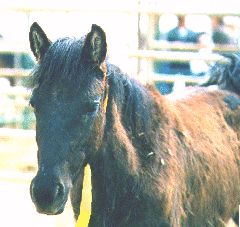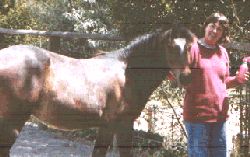|
Wild horses are also designed to consume and digest "low grade fuels". Therefore it is not healthy for the BLM to suddenly place captured animals on high calorie diets. The sudden change could actually be damaging to the animals. As a result, many of the animals you will see offered for adoption may look underweight and have rough coats.
Typically once these horses are brought into a less difficult environment and are fed sensibly, receive some grooming and get reasonable exercise (yet don't have to burn excess calories for survival), they start to take on the appearance what we would consider "normal" based on the domestic horses which we are used to seeing. In fact with good nutrition and proper exercise, these horses can develop into some downright good looking specimens, many which might not be recognized as former BLM horses except for the familiar freezemark and occasionally those 2-foot (or longer) flowing manes .
Another tip: Take pictures at regular intervals as your horse adjusts to domestic life. After a few months you may have forgotten how much transformation has taken place since the day you first spotted your adoptee in the BLM holding pen. Please note: This is not a BLM operated or BLM sponsored site. It is run by private wild horse and burro enthusiasts. We are thankful to the BLM for providing some of the information and graphics which appear in these pages. 
Go to KBR Training SectionReturn to KBR World of Wild Horses & BurrosGo to other Wild Horse LinksGo To
|

 In most instances wild horses are rounded up when their numbers exceed what
the BLM naturalists establish that the land can support. In short, they
are running out of food. Depending on the time of year and the condition
of the range, horses gathered off the lands can be pretty scrawny and rough
looking. During emergency roundups, some horses could appear to be
bordering on starvation, although they are hardy creatures and usually
aren't in as poor condition as their appearance would suggest.
In most instances wild horses are rounded up when their numbers exceed what
the BLM naturalists establish that the land can support. In short, they
are running out of food. Depending on the time of year and the condition
of the range, horses gathered off the lands can be pretty scrawny and rough
looking. During emergency roundups, some horses could appear to be
bordering on starvation, although they are hardy creatures and usually
aren't in as poor condition as their appearance would suggest.
 If in doubt, ask the BLM personnel what type of land the horses you are
looking at came from, how they should look when they fill out and how well
the other horses adopted from the same area have done. If you do adopt,
BLM literature, plus tips from the wranglers, can help guide you in
providing a good diet which will "fill out" your adoptee without overdoing
things.
If in doubt, ask the BLM personnel what type of land the horses you are
looking at came from, how they should look when they fill out and how well
the other horses adopted from the same area have done. If you do adopt,
BLM literature, plus tips from the wranglers, can help guide you in
providing a good diet which will "fill out" your adoptee without overdoing
things.